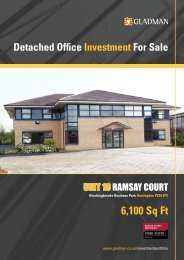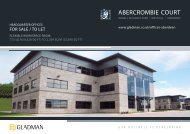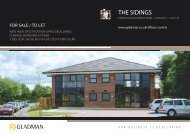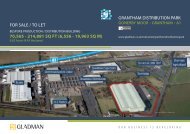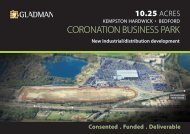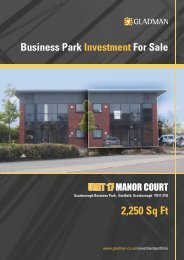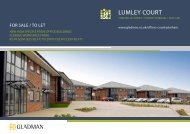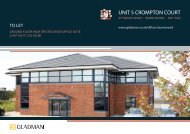Proposed Mixed Business and Retail Development ... - Gladman
Proposed Mixed Business and Retail Development ... - Gladman
Proposed Mixed Business and Retail Development ... - Gladman
- No tags were found...
Create successful ePaper yourself
Turn your PDF publications into a flip-book with our unique Google optimized e-Paper software.
<strong>Proposed</strong> <strong>Mixed</strong> <strong>Business</strong> <strong>and</strong> <strong>Retail</strong><br />
<strong>Development</strong>, Barbush, Dunblane<br />
Commentary on the Application of the<br />
Sequential Approach<br />
December 2010<br />
reference: Document3<br />
Contact: Keith Hargest<br />
Tel: 0131 443 8813<br />
Email: keith.hargest@btconnect.com
Barbush, Dunblane<br />
Note on Application of the Sequential Approach<br />
1 Introduction<br />
1.1 This note provides further comments on the interpretation <strong>and</strong> application of the sequential approach to<br />
the identification of potential sites for a new foodstore in Dunblane. In particular it considers the<br />
categorisation of proposed alternative foodstore sites at Dunblane Golf Course <strong>and</strong> Kippenross (Vico-<br />
Tesco) as well as the proposal by <strong>Gladman</strong> <strong>Development</strong>s Ltd at Barbush, Dunblane.<br />
1.2 This note has been prepared specifically as a response to comments made by planning officers at<br />
Stirling Council sent by e-mail to Dunblane Community Council dated 2 nd December. In this e-mail it is<br />
stated that “We consider the other Vico <strong>and</strong> Ristol sites to be in 'edge of centre' locations despite being<br />
located within the Green Belt <strong>and</strong> Countryside. The Structure Plan defines an edge of centre as follows:<br />
'A location within easy walking distance of the town centre, <strong>and</strong> usually adjacent to the town centre <strong>and</strong><br />
providing parking facilities that serve the centre as well as the store, enabling one trip to serve several<br />
purposes'. This definition is merely a description of a location <strong>and</strong> what benefits it can offer being next to<br />
the town centre. There is nothing in the <strong>Development</strong> Plan or in Scottish Planning Policy that precludes<br />
a location being considered edge of centre if it is also countryside <strong>and</strong>/or Green Belt.”<br />
1.3 It is considered that certain aspects of this statement are correct, however, the key aspect of the<br />
application of the sequential approach in these cases is whether or not the alternative sites can be<br />
accurately described as “edge of centre”. This matter is addressed in some detail in the <strong>Retail</strong> Impact<br />
Assessment submitted on behalf of <strong>Gladman</strong> <strong>and</strong> full reasons as to why neither of the alternative sites<br />
can be categorised as edge-of-centre is given in the RIA. In contrast the e-mail from Stirling Council is<br />
simple an assertion with no justification provided.<br />
1.4 In order to explain fully the basis for categorising potential retail (or other town centre uses) sites under<br />
the sequential approach regard should be given to each of the following:<br />
• The <strong>Development</strong> Plan:<br />
o<br />
Clackmannanshire <strong>and</strong> Stirling Structure Plan.<br />
o<br />
Stirling Council Local Plan (including Alterations).<br />
• Scottish Planning Policy – including earlier statements of SPP prevalent at the time the<br />
development plan was approved/ adopted.<br />
• Stirling LDP Main Issues Report .<br />
• Relevant Legal Cases.<br />
December 2010 2
Barbush, Dunblane<br />
Note on Application of the Sequential Approach<br />
2 The Policy Framework<br />
The <strong>Development</strong> Plan<br />
Stirling Structure Plan<br />
2.1 The parts of the Structure Plan relevant to the sequential approach were approved by Scottish Ministers<br />
in 2002. Policies S4 <strong>and</strong> S5 require the application of the sequential approach for retail development<br />
proposals. The glossary of the Structure Plan defines this as follows:<br />
SEQUENTIAL APPROACH - This approach is adopted when selecting sites for new retail, commercial leisure<br />
developments, other key town centre uses or housing. First preference should be for town centre sites,<br />
where sites or buildings suitable for conversion are available, followed by edge of centre sites, <strong>and</strong> only<br />
then by out of centre sites in locations that are, or can be made, easily accessible by a choice of means<br />
of transport.<br />
2.2 Categories of sites are identified as follows:<br />
TOWN CENTRE - The term town centre is used to cover town <strong>and</strong> district centres which provide a broad<br />
range of facilities <strong>and</strong> services <strong>and</strong> which fulfil a function as a focus for both the community <strong>and</strong> public<br />
transport. It excludes retail parks, neighbourhood centres <strong>and</strong> small parades of shops of purely local<br />
significance<br />
EDGE OF CENTRE - A location within easy walking distance of the town centre, <strong>and</strong> usually adjacent to the<br />
town centre <strong>and</strong> providing parking facilities that serve the centre as well as the store, enabling one trip to<br />
serve several purposes.<br />
OUT OF CENTRE - A location which is separate from a town centre but within the urban area, including<br />
programmed extensions in approved <strong>and</strong> adopted development plans.<br />
2.3 As will be noted below these definitions are identical to those provided in National Planning Policy 8<br />
Town Centres <strong>and</strong> <strong>Retail</strong>ing which was prevailing at the time the Structure Plan was approved.<br />
Stirling Local Plan<br />
2.4 The relevant part of the Stirling Local Plan is Alteration 1A which was adopted in 2007. Policy ED12 in<br />
this Alteration sets out criteria to be met by all new retail development – in relation to the sequential<br />
approach it refers back to Structure Plan policies.<br />
2.5 The Alteration does, however, provide a glossary of definitions. Although there are some changes in the<br />
wording (e.g. the reference to “broad range of retail <strong>and</strong> retail service facilities” in the definition of town<br />
centres) none of these modifications are significant in terms of the general application of the sequential<br />
approach. However the redefinition of town centres emphasises that the key issue, in terms of the<br />
sequential approach, is the relationship between development proposals <strong>and</strong> sites <strong>and</strong> the retail/retail<br />
service functioning of the town centre. It follows from this that it is more important to consider the<br />
physical <strong>and</strong> functional relationship between a proposed development site with retail/retail service<br />
December 2010 3
Barbush, Dunblane<br />
Note on Application of the Sequential Approach<br />
activities in a town centre than the location of the town centre boundary as drawn on the Local Plan<br />
map.<br />
2.6 From these definitions <strong>and</strong> the wording of the Structure Plan policy it is evident that there is no dispute<br />
between the applicants, their consultants <strong>and</strong> Stirling Council planning officers that, in the light of the<br />
above definitions:<br />
• None of the proposed retail sites in Dunblane can be categorised as a town centre site since all<br />
three sites are clearly located outwith Dunblane town centre.<br />
• That the Barbush site is an out-of-centre location in that it lies within the urban area of Dunblane.<br />
2.7 However there is dispute as to whether or not certain sites can be accurately described as “edge-ofcentre”.<br />
The development plan definitions have, in essence two requirements to be met for a site to be<br />
defined as edge-of-centre i.e. (i) that the location is within easy walking distance of a town centre <strong>and</strong> (ii)<br />
providing parking facilities that serve the centre as well as the development. The second requirement<br />
will be both dependent upon meeting the first (i.e. the car park, in order to serve the centre, must also be<br />
with easy walking distance of the centre) <strong>and</strong> must be made available to users of the town centre (i.e. in<br />
normal practice this means that parking should be free for a period of time to allow users to undertake<br />
normal activities etc in the town centre). This latter requirement will normally be a matter of operational<br />
practice by the owners/operators of the retail development <strong>and</strong> can be subject to conditions/legal<br />
agreement attached to a planning consent.<br />
2.8 In essence therefore, the key issue to be addressed in categorising a site as “edge-of-centre” is whether<br />
or not it is considered to be within easy walking distance of the town centre – noting in the Local Plan<br />
that it is the retail/retail service functions of the town centre that is crucial to the definition of the town<br />
centre. As noted the definitions of edge-of-centre <strong>and</strong> out-of-centre are derived directly from the<br />
prevailing Scottish/National Planning Policy that was in place at the time the plans were prepared <strong>and</strong><br />
adopted/approved (<strong>and</strong>, indeed, remain in place at the current time). It is, therefore, highly relevant that<br />
the issue of how one assesses whether or not a site is within “easy” walking distance was specifically<br />
addressed in SPP8 published in August 2006 (i.e. it was prevailing at the time that Alteration 1A was<br />
adopted). In order to fully underst<strong>and</strong> the application of the sequential approach as set out in the<br />
development plan one must have regard to relevant Scottish Planning Ppolicy.<br />
National/Scottish Planning Policy<br />
2.9 At the time of the approval of the Structure Plan in 2002 NPPG8 provided national planning policy for<br />
retail development. This set out the sequential approach <strong>and</strong> the definitions of town centre, edge-ofcentre<br />
<strong>and</strong> out-of-centre. The definitions used in the Structure Plan quoted above are the same as<br />
those used in NPPG8.<br />
2.10 Through a number of appeals during the late 1990s <strong>and</strong> early 2000s it became apparent that a frequent<br />
dispute was whether or not proposed retail sites could, or could not be described as edge-of-centre. In<br />
response to this when SPP8 was published in 2006 this included an explanation of whether or not sites<br />
can be regarded as edge-of-centre (para 18):<br />
December 2010 4
Barbush, Dunblane<br />
Note on Application of the Sequential Approach<br />
2.21 It inevitably follows from the above that, in accord with both the development plan <strong>and</strong> Scottish Planning<br />
Policy, if the Golf Club <strong>and</strong> Kippenross sites are not edge-of-centre then they cannot be considered as<br />
potential retail sites under the sequential approach – they would then not be either town centre, edge-ofcentre,<br />
other commercial centre or out-of-centre sites. The sequential approach does not contemplate<br />
such a site as a potential location for retail development regardless of the availability of alternatives.<br />
Policy Framework: Conclusions<br />
2.22 From the above the following points can be concluded in relation to the application of the sequential<br />
approach:<br />
• The Barbush site is out-of-centre.<br />
• There are no suitable or available town centre sites.<br />
• The development plan policy in relation to the sequential approach reflects Scottish Planning Policy<br />
(except that it does not include “other commercial centres” <strong>and</strong> the definition of town centres is<br />
amended slightly in the adopted Local Plan Alteration 1A).<br />
• Guidance on how to interpret edge-of-centre locations is provided in SPP8 – the current SPP is<br />
consistent (although less detailed) with this Policy.<br />
• A range of questions/tests can be considered to identify whether or not a site is edge-of-centre.<br />
• From the Local Plan a key consideration is the relationship between the proposed development site<br />
<strong>and</strong> retail/retail service activities in the town centre rather than the boundary of the centre as shown<br />
on the Local Plan map.<br />
• It would be unusual to identify an edge-of-centre site which is not physically adjacent to the defined<br />
town centre (<strong>and</strong> adjacent to retail/retail services facilities in accord with the adopted Local Plan<br />
Alteration 1A).<br />
• If either of alternative sites do not satisfy the definition of edge-of-centre then their location is such<br />
that neither are in locations that would be considered as potentially suitable for a town centre use or<br />
retail development regardless of the availability/suitability of alternatives.<br />
December 2010 7
Barbush, Dunblane<br />
Note on Application of the Sequential Approach<br />
3 Consideration of Alternative Sites as Edge-of-<br />
Centre<br />
3.1 The key issue when considering the sequential approach for Dunblane is whether or not either the<br />
Kippenross or Golf Club sites can be accurately described as edge-of-centre reflecting the above policy<br />
framework.<br />
It is also necessary, as part of the sequential approach, to consider whether the sites can<br />
genuinely be regarded as reasonably available – the fact that a planning application has been lodged for<br />
a site does not indicate that the site is available.<br />
3.2 It should also be recognised that the sequential approach is only one of a number of important planning<br />
policy considerations which need to be considered in addition to the sequential approach. Indeed it can<br />
be quite reasonable for the planning authority to conclude that a site which is not sequentially preferable<br />
should be the preferred location for development of a foodstore as a result of a combination of planning<br />
benefits associated with the proposal <strong>and</strong>/or planning disbenefits associated with potentially sequentially<br />
preferable alternative sites.<br />
Dunblane Golf Course<br />
3.3 This site is not located within the urban area of Dunblane but forms part of the Green Belt in the adopted<br />
Local Plan. It is not located in any area proposed for the extension of the urban area in the development<br />
plan. Although the boundary of the application site is located on the east side of the Perth Road the<br />
retail area of the site is located some distance from the boundary of the town centre <strong>and</strong> significantly<br />
further from the principal retail area of the town centre. Although parts of the site are less than 300m<br />
from the retail area of the town centre its linkages to the town centre are poor:<br />
• Access to the site from the town centre requires access along a significant gradient – the western<br />
part of the proposed site is approximately 17m (55 ft) higher than the nearest part of the High<br />
Street.<br />
• There is no visual linkage between the site <strong>and</strong> the principal retail frontages in the town centre.<br />
• There are non-commercial uses (residential properties) between the site <strong>and</strong> the town centre.<br />
3.4 Regard should also be had to the character of the site once developed. The site comprises a golf<br />
course <strong>and</strong> this use will remain to the west of the site. To the south is Kippenross which comprises<br />
parkl<strong>and</strong>/plantations whereas to the north is an area of low density housing. It is clear that the character<br />
<strong>and</strong> setting of the site following development will be completely different from the town centre – this site<br />
will not operate as an extension of the town centre, rather it will be quite separate.<br />
3.5 It follows from this that the site cannot be regarded as either an edge-of-centre site. Given its location<br />
outwith the urban area of the town (<strong>and</strong> it is not included within any planned extension identified in the<br />
development plan) it is not, therefore, an out-of-centre site.<br />
3.6 In the RIA it was noted that there are other important deficiencies associated with the site in planning<br />
terms:<br />
December 2010 8
Barbush, Dunblane<br />
Note on Application of the Sequential Approach<br />
• The site cannot be regarded as available within a reasonable timescale. As noted in the RIA the<br />
occupiers of the site object to the proposal. The Golf Club indicate that their lease runs until 2044<br />
<strong>and</strong> that the owners need to give at least 4 years notice to the Club if redevelopment is proposed.<br />
There is also an obligation on the owners to provide replacement facilities of at least the same<br />
quality. The Club indicates that it will take at least 10 years before the site can become available for<br />
development.<br />
• The proposal will adversely affect an important sporting facility within the community <strong>and</strong> that, even<br />
if all the required measures were implemented by the developers it would, according to the Club<br />
“threaten the Club’s future existence <strong>and</strong> will, without doubt, reduce the quality of the golfing<br />
facility”.<br />
• The site is, as noted, located in the Green Belt. The development of this area will result in the loss<br />
of part of the important l<strong>and</strong>scape setting of the town.<br />
• In the LDP site assessment process the Council’s own assessment of the site considers that the<br />
site is detached from the town centre <strong>and</strong> is “unlikely to feel integrated” <strong>and</strong> [the site is]<br />
“problematic with regards to maintaining l<strong>and</strong>scape character or making new, high quality<br />
l<strong>and</strong>scapes that would contribute positively to the setting of the quality of Dunblane”. It is considered<br />
that this is a reasonable assessment of the site.<br />
• The development would result in significant adverse l<strong>and</strong>scape impacts <strong>and</strong> loss of amenity. The<br />
site is clearly environmentally sensitive <strong>and</strong> an important asset for the l<strong>and</strong>scape setting of the town.<br />
3.7 The conclusions from the above analysis are that, in terms of the sequential approach:<br />
• Although located comparatively close to the boundary of town centre there are a number of factors<br />
that mean that the site will not be able to integrate with the existing retail/retail service area of the<br />
town centre. In particular the site is not well related to existing retail <strong>and</strong> retail service uses in the<br />
town centre. The site cannot be accurately described as edge of centre.<br />
• The site is outwith the existing <strong>and</strong> planned urban area (in the approved/adopted development plan)<br />
<strong>and</strong> is, therefore not an out-of-centre site.<br />
• It inevitably follows from the above that the site fails to satisfy the sequential approach.<br />
In addition there are a number of other important planning considerations that indicate that the site<br />
should not be developed for the proposed retail development. The site is not available within a<br />
reasonable timeframe, its development would adversely affect an important community <strong>and</strong> sporting<br />
resource, <strong>and</strong> it would adversely affect the l<strong>and</strong>scaping setting of the town.<br />
Vico-Tesco Site: Kippenross<br />
3.8 A comparable analysis can be undertaken for the Kippenross site:<br />
December 2010 9
Barbush, Dunblane<br />
Note on Application of the Sequential Approach<br />
• Linkages to the town centre suffer similar problems to those identified for the Golf Club. The<br />
western part of the site is approximately 200 m from the beginning of shops in the High Street but if<br />
the store is located to the eastern part of the site then the distance will be more than double this.<br />
Pedestrian access would require the crossing of Perth Road which is a dual carriageway in this<br />
location <strong>and</strong> there are non-commercial/town centre uses between the site <strong>and</strong> the town centre.<br />
There is also no visual linkage between the principal shopping area of the town centre <strong>and</strong> the site<br />
<strong>and</strong>, as noted, there is a significant incline between the town centre <strong>and</strong> the site (the location of the<br />
store would be about 10m higher than the nearest point of the High Street <strong>and</strong> significantly higher<br />
than the beginning of the retail/retail service uses in the town centre).<br />
• Regard should also be had to the character of the site once developed. The site comprises a<br />
plantation/parkl<strong>and</strong> <strong>and</strong> this use will remain to the west <strong>and</strong> south of the site. To the north is the<br />
golf club. It is clear that the character <strong>and</strong> setting of the site following development will be<br />
completely different from the town centre – this site will not operate as an extension of the town<br />
centre, rather it will be quite separate.<br />
3.9 For the above reasons the site cannot be regarded as edge-of-centre.<br />
3.10 As with the Golf Club site the Kippenross site is located outwith the urban area of the town <strong>and</strong> is not<br />
included within any planned extension of the urban area in the development plan. It is not, therefore, an<br />
out-of-centre site.<br />
3.11 The site also has a number of additional difficulties <strong>and</strong> has adverse impacts on other planning<br />
concerns:<br />
• There is uncertainty as to whether the site can be regarded as available. <strong>Development</strong> of the site<br />
requires the felling of the existing woodl<strong>and</strong> <strong>and</strong>, although an application has been lodged for the<br />
appropriate felling license it is understood that this is not to be determined until the outcome of the<br />
LDP process is completed. If this is the case the site cannot be regarded as potentially available<br />
until the license is granted.<br />
• Its development will adversely affect the l<strong>and</strong>scape setting of the town.<br />
• The Kippenross Estate which is identified in the Inventory of Gardens <strong>and</strong> Designed L<strong>and</strong>scapes in<br />
Scotl<strong>and</strong>. Its development will therefore conflict with policies aimed at protecting these nationally<br />
important l<strong>and</strong>scapes <strong>and</strong> gardens. On inspection of the Inventory the development in this location<br />
will affect the l<strong>and</strong>scape setting of the estate when viewed northwards from Kippenross House. In<br />
addition it will adversely affect the Darn Road which is identified in the Inventory as a “Sunk Road”<br />
which was the old drove road between Dunblane <strong>and</strong> Bridge of Allan. The road takes the form of a<br />
narrow lane, sunk in paces to 2m in depth with dry stone walls on either side.<br />
• The impact on the historic l<strong>and</strong>scape <strong>and</strong> heritage features has been noted by Historic Scotl<strong>and</strong><br />
who have confirmed in their letter of 4 th August 2010 to Stirling Council in which they state that, in<br />
relation to the proposed development of a Tesco store in this location that “it remains our preference<br />
December 2010 10
Barbush, Dunblane<br />
Note on Application of the Sequential Approach<br />
that a potential l<strong>and</strong> allocation within the boundary of the designed l<strong>and</strong>scape is not included within<br />
the proposed plan”.<br />
3.12 In summary the Vico/Kippenross site:<br />
• Does not satisfy the sequential approach – it is neither edge-of-centre nor out-of-centre.<br />
• There is uncertainty as to whether the site can be regarded as reasonably available.<br />
• The site is in the Green Belt.<br />
• Its development will adversely affect the l<strong>and</strong>scape setting of Dunblane.<br />
• Its development will adversely affect the Kippenross Estate policies which are a designated historic<br />
l<strong>and</strong>scape <strong>and</strong> garden.<br />
December 2010 11
Barbush, Dunblane<br />
Note on Application of the Sequential Approach<br />
4 Conclusions<br />
This note sets out clearly the basis for applying the sequential approach as set out in the development<br />
plan <strong>and</strong> Scottish Planning Policy. It applies the approach consistently to the proposed sites for a<br />
foodstore development in Dunblane <strong>and</strong> the conclusions from this are clear that neither of the<br />
Kippenross (Vico/Tesco) nor Golf Club sites can be accurately described as edge-of-centre sites. In<br />
addition both sites are outwith the urban area <strong>and</strong> neither are included within planned extensions of the<br />
urban area contained in the development plan. Therefore neither site is an out-of-centre site.<br />
Therefore neither site satisfies the sequential approach as set out in the development plan or in Scottish<br />
Planning Policy. Both sites are also unacceptable for other planning reasons – they are both in the<br />
Green Belt, their development will adversely affect the l<strong>and</strong>scape setting of the town, the Golf Club site<br />
will adversely affect an important community/sports facility <strong>and</strong> the Kippenross site will adversely affect<br />
an important heritage site.<br />
The Barbush site is agreed to be an out-of-centre site. In the absence of suitable or available edge-ofcentre<br />
or town centre sites this site satisfies the sequential approach.<br />
In the RIA the Abattoir site is also identified although this is not the subject of a planning application.<br />
This site is identified only as possibly being available in a time period of 5-10 years <strong>and</strong> cannot therefore<br />
be regarded as available within a reasonable time frame. In addition the Abattoir site is too small to<br />
accommodate a foodstore for main food shopping requirements <strong>and</strong> access arrangements are subst<strong>and</strong>ard.<br />
This site is, therefore, unsuitable for the proposed development.<br />
Drawing all the above the benefits of the Barbush site are clear:<br />
• It is the only site that satisfies the sequential approach.<br />
• The principal two competing sites are in locations that are not contemplated as potential retail<br />
locations in the sequential approach. Furthermore both will result is substantial adverse impacts on<br />
important planning concerns.<br />
• The development of the Barbush site offers significant potential planning benefits associated with<br />
the development of business space.<br />
Keith Hargest<br />
Hargest Planning Ltd<br />
21.12.2010<br />
December 2010 12



